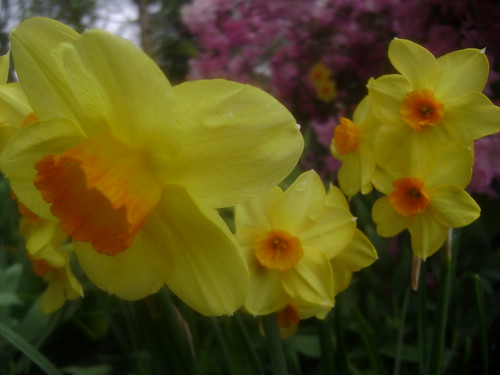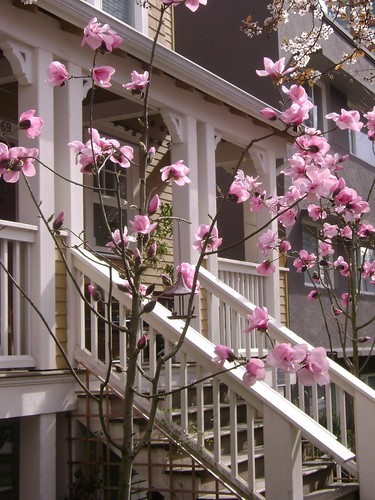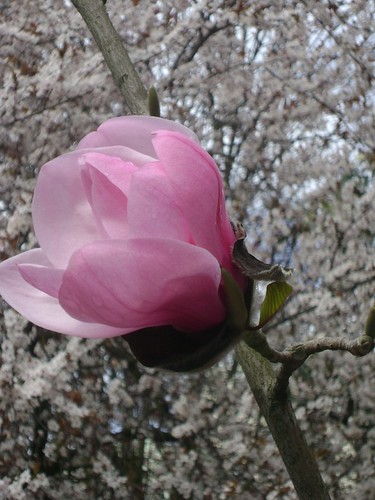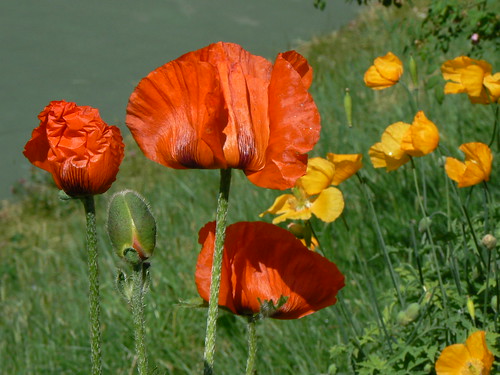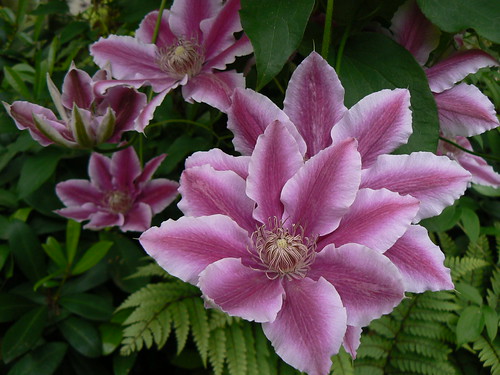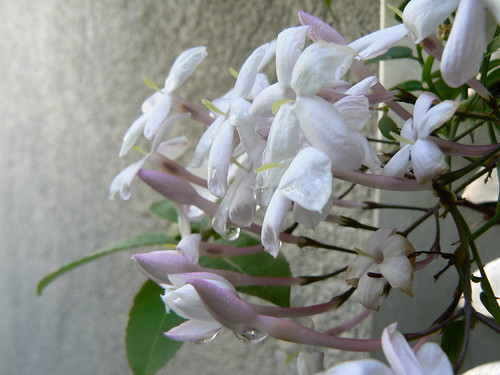Olfactory Quilt: Spring 2008 in Vancouver
Spring is about to come to an end come June 21st. And since I usually prefer to spend my Springs in Israel, this might be my only chance to create this type of collage on SmellyBlog, capturing my impressions of Spring in sequence from March till June. Besides, I feel this Spring was the first one I actually “got” – just like an obscure and fleeting perfume that won’t easily let you discern it’s different notes. Being spoiled with Middle-Eastern Springs, that are all about a showy explosion of flowers – both colours and smells – the subtleties of a West Coast Spring have escaped me for years.
Spring in Vancouver always seem to arrive early, with the first brave tree blossom – plum and cherry. But it is the daffodils and the tulips that announce it more explicitly, encouraging kindergarten and schoolteachers to decorate their classrooms with yellow cutouts of certain floral shapes.
Daffodils
Daffodils have a scent that I am yet to be able to describe. It’s altogether clean and soapy and at the same time has that dirty indolic floral underlining it all. And tulips have no scent at all for all I can tell from a floral perspective – perhaps one can smell a green hint from the petals and the stingy odour of pollen.
Mysterious and invisible blossoms
It seems that here, the tinier the flower, the more fragrant it is. If the air is not completely washed out by air, you may detect an overall floral intoxication lingering in the air. Deemed urinal-smelling by some, to me this is very similar to the scent of wild narcissus from back home. However, this is happening at the very beginning of spring, when there are hardly any blossoms to be seen – definitely not narcissus. It took me 10 years to gun down the source of this olfactory pollution: privet blossom.
Magnificent Magnolias
 Magnolia Highrise, originally uploaded by Ayala Moriel.
Magnolia Highrise, originally uploaded by Ayala Moriel.Magnolias are not just a Southern thing (although the porch pictured below may as well pass for one). There are trees in every shape, size and colour spread around the city, and I am very thankful for that. There are white magnolias, pink magnolias and even very dark red-wine magnolias. The most beautifully fragrant are the white and the pink (with some exceptions – each tree has it’s own unique scent it seems). The flowers are outrageously beautiful. Glorious really.
Cherry Blossoms
Cherry blossoms are the never-tiring cliché of spring just as much as almond blossoms are in Israel’s Tu BiShvat. With the strong influence of Japanese culture in Vancouver, there is in fact a (quite) Sakura festival happening in the city, the centre of which takes place on the weekend, under the cherry blossom boulevard of Burrard SkyTrain Station. I have missed this year’s festival but you could say I constantly celebrated with my own perfume tribute to the poem “In A Station of the Metro” which is my interpretation of this exact locale. With this and thanks to the whimsical hot-and-cold weather prolonging the season (freezing the flowers and than defrosting them, almost literally!) -it’s been certainly a Sakura spring for me in more ways than I can reveal in such a short paragraph.
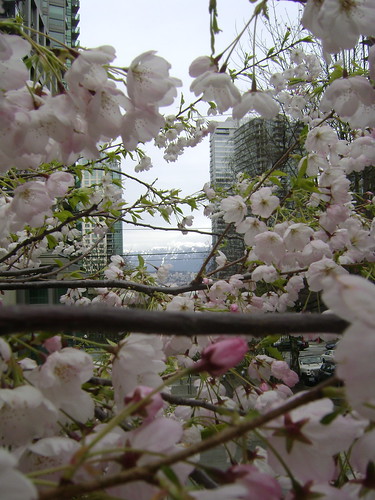
Parallel Horizons and Vanishing Points, originally uploaded by Ayala Moriel.
Hyacinths and the 7 S's
Hyacinths hold a special place in the Persian New Year’s celebration. They are presented as an offering on the table with the 7 S’s (Haft Seen) – various objects (mostly living objects – such as fish and sprouted wheat) to bless the new year. Hyacinth symbolize life and beauty. Within closed quarters, these grape-like clusters of blue, pink or white flowers may be overbearing, but outdoors in the gardens on the typical chilly spring days, they are green, fresh and beautiful and positively intoxicating.
Tulips
In contrast to the fragrant hyacinths, these bulb flowers have no scent at all to write home about. Perhaps there is some greenness about them, but if there is any scent at all I suspect it comes from the pollen-covered stamens. Tulips of all shapes, colours and patterns take over the city for a short period of time, and if you are not careful you may get convinced that you are actually in the Netherlands during early April. This particular tulip in the photo looks like a flame, with its dark (nearly black) petals trimmed with gold.
Lily of the Valley
Come late April, and silver bell-like offerings of lily of the valley pop up in high end flower shops around the city. Although they could, you will rarely see them growing in gardens. This year I have made a point of filling my home with little bunches as long as I could find them. Needless to say, I did not regret it one bit!

Lily of the Valley, originally uploaded by Ayala Moriel.
Miscellaneous beautiful flowers, of now particular scent
The following is literally a collection of flowers that caught my eye and that have become iconic symbols of Vancouver’s spring for me. Bleeding hearts, with their drop-dead-gorgeous jewel-like designs; Irises, both yellow and purple, popping up in skunky marshes and ponds; poppies with their strange un-red colours or the cultivated gigantic vermillion awe-inspiring opiatic presence. And lastly, this strange passionflower-like climbing shrub that I discovered in the back garden and I have no idea what it is.
Peach Scented Flowers
The identity of this bush/shrub is unknown to me and it bloosm with the most enchanting peach scent that reminds me of both lilac, osmanthus and of course - peach. If you know its identity, please do tell.
Rhododendrons and Lilacs
I’ve already raved about the beautiful rhododendron gardens of the city before and I could probably blog about them every day when they’re in bloom. Needless to say – I’m smitten with rhododendrons and the variety of colours, shapes and fragrances they add to this green & gray place I’m living in. The particular combination of rhododendron flower on a backdrop of lilac bush in full blossom is like adding a cherry on the top. Now, this is a perfume.
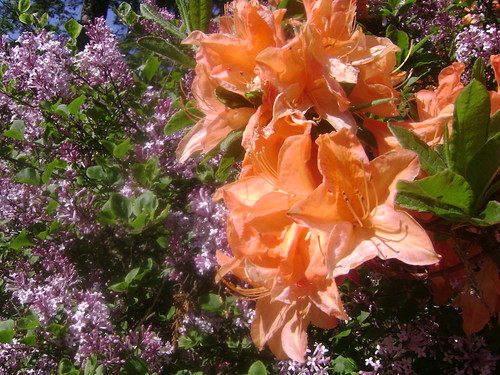
Rhododendron & Lilac, originally uploaded by Ayala Moriel.
Summer Just Around the Corner
You know summer is at the door when the peonies start to bloom and when you can smell the jasmine flowers in my balcony. I picked a little bunch of jasmines for a building-block photoshoot (the results of which I hope will be of much use in the not-so-far future on both my website and printed guides). Just three of these small blossoms were enough to perfume my entire bedroom. This was your daily-dose of an aphrodisiac.
The identity of this bush/shrub is unknown to me and it bloosm with the most enchanting peach scent that reminds me of both lilac, osmanthus and of course - peach. If you know its identity, please do tell.
Rhododendrons and Lilacs
I’ve already raved about the beautiful rhododendron gardens of the city before and I could probably blog about them every day when they’re in bloom. Needless to say – I’m smitten with rhododendrons and the variety of colours, shapes and fragrances they add to this green & gray place I’m living in. The particular combination of rhododendron flower on a backdrop of lilac bush in full blossom is like adding a cherry on the top. Now, this is a perfume.

Rhododendron & Lilac, originally uploaded by Ayala Moriel.
Summer Just Around the Corner
You know summer is at the door when the peonies start to bloom and when you can smell the jasmine flowers in my balcony. I picked a little bunch of jasmines for a building-block photoshoot (the results of which I hope will be of much use in the not-so-far future on both my website and printed guides). Just three of these small blossoms were enough to perfume my entire bedroom. This was your daily-dose of an aphrodisiac.



